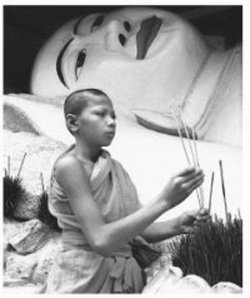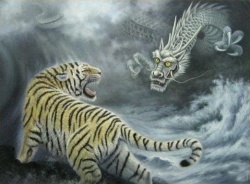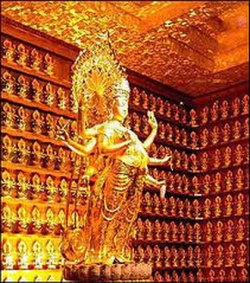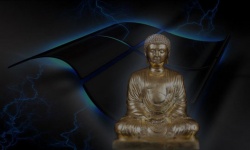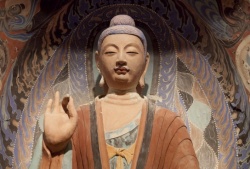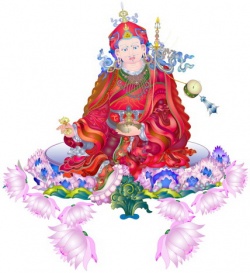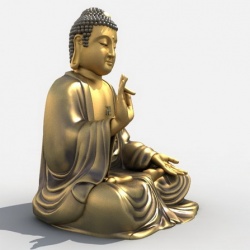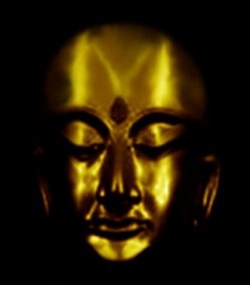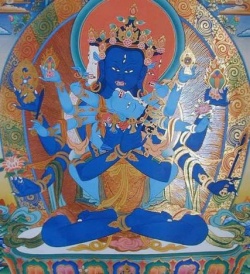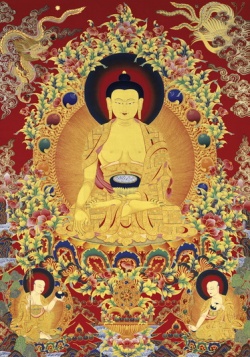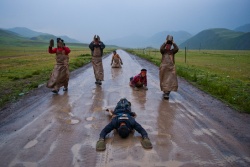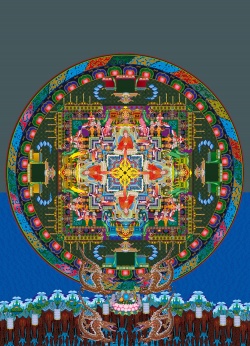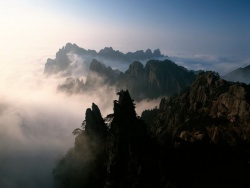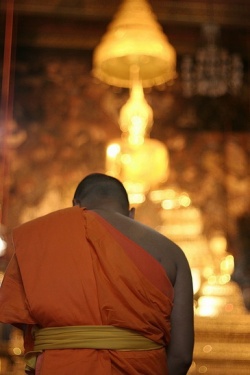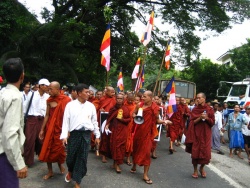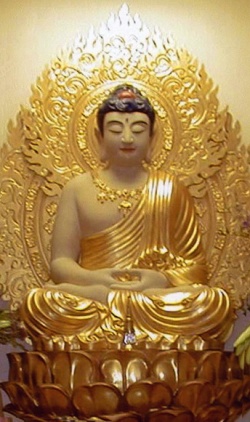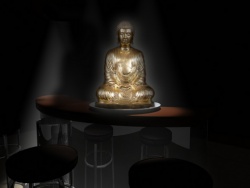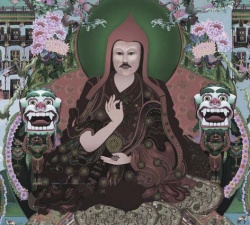Difference between revisions of "The Emptiness of Codependent Origination"
| Line 200: | Line 200: | ||
36. According to Muhlberger (op cit.), [[Brahmanical]] classics such as the {{Wiki|Mahabharata}}, the [[Arthashastra]] and the Manu-Smrti, promoted {{Wiki|hierarchy}} and demoted the egalitarianism previously attained; at their most extreme, "the Manu-Smrti was to formulate a [[view]] of {{Wiki|society}} where [[human]] equality was {{Wiki|non-existent}} and [[unthinkable]]". | 36. According to Muhlberger (op cit.), [[Brahmanical]] classics such as the {{Wiki|Mahabharata}}, the [[Arthashastra]] and the Manu-Smrti, promoted {{Wiki|hierarchy}} and demoted the egalitarianism previously attained; at their most extreme, "the Manu-Smrti was to formulate a [[view]] of {{Wiki|society}} where [[human]] equality was {{Wiki|non-existent}} and [[unthinkable]]". | ||
| − | 37. As Thapar describes Ramrajya: "There is a [[concentration]] of power in the [[king]], an administrative {{Wiki|hierarchy}}, a clearly defined territory with some notion of boundaries, a capital … a treasury, a regularly constituted {{Wiki|army}} and a range of allies and foes". (Romila Thapar, From [[Lineage]] to State: {{Wiki|Social}} [[Formations]] in the Mid-First Millennium B.C. in the [[Wikipedia:Ganga (goddess)|Ganga]] Valley. {{Wiki|Oxford University Press}}, {{Wiki|New Delhi}}, 1990, p. 134.) [[Ayodhya]], the capital, prefigures many later states (both [[East]] and [[West]]) in so far as it boasted [[divine]] intervention on behalf of the {{Wiki|monarchy}} as a regular [[characteristic]]. In recent history, the Bharatiya Janata Party (BJP) (and its ideological wing, the [[Vishwa]] [[Hindu]] Parisha held together a shaky coalition in the [[Indian]] federal parliament, and focused much of its national campaigning, particularly in rural illiterate areas, on visions of the re-establishment of Ramrajya or a righteous {{Wiki|kingdom}}. The [[Vishwa]] [[Hindu]] Parishad (VHP) International | + | 37. As Thapar describes Ramrajya: "There is a [[concentration]] of power in the [[king]], an administrative {{Wiki|hierarchy}}, a clearly defined territory with some notion of boundaries, a capital … a treasury, a regularly constituted {{Wiki|army}} and a range of allies and foes". (Romila Thapar, From [[Lineage]] to State: {{Wiki|Social}} [[Formations]] in the Mid-First Millennium B.C. in the [[Wikipedia:Ganga (goddess)|Ganga]] Valley. {{Wiki|Oxford University Press}}, {{Wiki|New Delhi}}, 1990, p. 134.) [[Ayodhya]], the capital, prefigures many later states (both [[East]] and [[West]]) in so far as it boasted [[divine]] intervention on behalf of the {{Wiki|monarchy}} as a regular [[characteristic]]. In recent history, the Bharatiya Janata Party (BJP) (and its ideological wing, the [[Vishwa]] [[Hindu]] Parisha held together a shaky coalition in the [[Indian]] federal parliament, and focused much of its national campaigning, particularly in rural illiterate areas, on visions of the re-establishment of Ramrajya or a righteous {{Wiki|kingdom}}. The [[Vishwa]] [[Hindu]] Parishad (VHP) International General Secretary, Praveen Togadia said the three primary issues on the VHP's agenda were the establishment of Ram rajya, the reconstruction of the Ram [[temple]] at [[Ayodhya]] and a [[Hindu]] rashtra. ("Ram rajya, [[temple]] and [[Hindu]] rashtra top VHP agenda", July 20 2003, at [[India]] Info at http://news.indiainfo.com/spotlight/ayodhya/20togadia.html.) The mythologized [[Ayodhya]] was said to have had a rich {{Wiki|cultural}} [[life]] in which all the citizens participated; this is certainly not true of contemporary [[Ayodhya]], a civilizational backwater known only for clashes over Ramjanmabhumi. |
38. [[Aliens]] are denoted as [[rakshasas]] or {{Wiki|metaphorical}} {{Wiki|demons}}, and [[mlecchas]], a generic term to denote 'the other' and covering all non-Aryans or those not following [[varna]] asrama and [[brahminic]] [[rites]]. In the {{Wiki|Ramayana}}, they are depicted variously as nri-chakshas or cannibals, rakta-pas or blood-drinkers, ratri-charas or night-walkers, and malina-mukhas or black-faced. | 38. [[Aliens]] are denoted as [[rakshasas]] or {{Wiki|metaphorical}} {{Wiki|demons}}, and [[mlecchas]], a generic term to denote 'the other' and covering all non-Aryans or those not following [[varna]] asrama and [[brahminic]] [[rites]]. In the {{Wiki|Ramayana}}, they are depicted variously as nri-chakshas or cannibals, rakta-pas or blood-drinkers, ratri-charas or night-walkers, and malina-mukhas or black-faced. | ||
Revision as of 15:39, 20 March 2014
by Maggie Grey(1)
Introduction
The Indian subcontinent's most significant contribution to International Relations has been the cultural technology (tantra) of non-violent protest (ahimsa). Activated by Mahatma Gandhi during the struggle for Indian independence, mass practice of this simple tantra accelerated India's political liberty by alerting the global community to Indian suffering.(2) Its practice was paramount in the struggle, championed by Martin Luther King Jr., for Black rights in America, and has played a pivotal role in global reformist and rights movements since. Yet in its essence, ahimsa was not a 20th century Gandhian conception but the updated message of the 6th century BCE ascetic Mahavira, the founder of Jainism and contemporary of the Buddha.
From meditational practices to origami, from yoga asanas to ikebana, and from the martial arts, to acupuncture, T'ai Chi, and bonsai, Eastern cultural technologies have been an important component of globalization since the end of World War II. As the world turns East, mandalas are perhaps the latest cultural technology to emerge from Asian cultures of self-reflection. These parallel historical processes in which the East has sought an understanding of existence from within, and the West from without, need both to be acknowledged.
The Western tradition has attempted to banish suffering by control of the external material forces assumed to cause suffering,(3) the Eastern tradition has attempted to understand the nature of suffering and our own agency in its arising. International society cannot continue to be guided by predominantly by the external, controlling consciousness – such a complex environment requires both.
What follows is an elaboration of an Eastern offering to the balance in the form of the doctrine of Codependent Origination and its corollary, Bhavachakra, or the Wheel of Life Mandala.(4) This article investigates the doctrine’s own dependent origins in ancient India and concludes by reflecting on its relevance in 21st century international relations.
[Editorial Note: The pivotal term employed in this article, ‘emptiness’ (Sanskrit: sunyata), is a simplified form of Codependent Origination and stresses the interdependent existence of all phenomena; that all phenomena are empty of their own existence and therefore contingent.]
Codependent Origination
The mandala of Codependent Origination(5) is concerned to explicate the ways in which human behaviour, including international political behaviour, is inescapably conditioned by compounding historical and contemporary phenomena. It argues that no phenomena, not even the international political, are independent or self-originating (sva-bhava); in Buddhist terms, all phenomena are ‘empty’.
Codependent Origination, though not traditionally applied to political affairs, provides a psycho-social model of the human condition that is compatible with classic Realist political texts. It finds much behaviour dependent on delusion (or ignorance), desire and aggression. These are termed either the ‘three fires’ or the ‘three poisons’. They are the propellant fuels of human behaviour and require discipline if they are not to stimulate suffering, aggression and death. The doctrine arose in Bharata (India) in the post-Vedic Age, an era of rapid domestic, regional and international change, as cities and states emerged from tribal societies, as technology and trade prospered, as public discourse flourished and memory was codified, as new degrees of cognitive freedom and self-perception were constructed from the foundations of tribal and village custom and myth, and as republicanism was weakened by consolidating monarchy. The human species had spent at least 150,000 years in sophisticating tribal and environmental relations and then conditions changed. In assessing the relevance of Codependent Origination and the Wheel of Life Mandala for the 21st century, it is instructive to examine those conditions on which the doctrine and Buddhism itself, were dependent. Parallels between the ancient north-Indian microcosm and dependent conditions of the emergent macrocosmic ‘global village’(6) or ‘global civilization’(7) are one vindication of the Wheel’s predictions of historically cyclical and accumulatively dependent behaviour; they are also exemplary of phenomenal emptiness.
A further purpose of this article is to show how the historical dependency of the early Buddhist clergy upon the good will of emergent political and economic actors, compromised the doctrine of Codependent Origination. The non-labouring Sangha was subsidized by the wider society, which gained merit by that subsidy. Monastics however were forbidden explicit political discourse, a compromise that disempowered the clergy and minimalized the doctrine. Politically and economically dependent discourse stressed the delusions, desires and conflicts of individuals, leaving political and economic ‘entities’ free to stoke the ‘three fires’. After two and a half millennia, state and non-state ‘arsonists’ have generated a delusional political economy of desire threatening the ecological sustainability of the planet, while world order is ‘guaranteed’ by forms of aggression ranging from cataclysmic nuclear warfare to terrorism. It is time to liberate the doctrine from its historically conditioned and ‘delusional’ focus on the individual and acknowledge the Realist cogency and global implications of Codependent Origination to ecological as well as international peace and security. This is to argue neither that the focus on the individual is delusional in itself, nor that an alternative doctrine could have been disseminated in the 6th century BCE; it is simply to argue that the most potent manifestations of ignorance, desire and aggression do not occur at the individual level but as a result of historically compounding collective bahaviours such as the state monopoly of violence.
An Axis of Emptiness
The 6th century BCE was an ‘axial’ period in Eurasian history,(8) for the Persians, the Greeks, the Chinese and the Hebrews, as well as the Indians. As first denoted by psychiatrist, historian and philosopher Karl Jaspers in The Origin and Goal of History (1949), this age stretched from 800-200 BCE, though peaking around 500 BCE. Jaspers claimed it was witness to "the most overwhelming fruitfulness … in the shaping of being-human".(9) More commonly known as the late Bronze Age or early Iron Age (depending upon diverse regional chronologies), ‘axial’ regions by the 6-5th centuries BCE, evidenced ‘complex interdependence’(10) or emptiness: social expansion, technological advancements, emerging markets, state formation, intellectual discourse and empire building.(11) Axial societies entered history: iron was smelted, transportation and irrigation mastered, the use of the horse militarized, cities and states founded. Empires acquired by the strategic use of violence, utilized the dependent condition, terror. Alphabets and scripts conditioned the recording of memory, the generation of history and science and new cognitive systems for conceiving of the world and sentient affairs.(12) The new technologies, hard and soft, allowed for both social development and the control and coercion of mass populations, and advances including the spiritual, were largely expropriated for government service.(13)
The emergence of state power was complemented though not necessarily addressed by intellectual and moral discourse.(14) Jaspers speaks too of the need for "the emergence of men to be emulated, in the shape of rulers and sages, whose deeds, achievements and destinies were in full view of the masses".(15) In Persia, a new state religion, founded by Zoroaster (circa 630-553 BCE) centred on a universal and eternal struggle between good and evil. Within Judaism, an extensive line of prophets, "the first of historians and the last of the mythmakers",(16) stressed the importance of social justice, personal ethics and humility before the tribal superpower.
In South Asia four non-discrete political formations mark this era: indigenous tribes, Aryan or Vedic village networks, tribal republics and kingdoms.(17) Emptiness had been transformed; change and complex interdependence acquired momentum as social formations expanded, trade flourished and power was consolidated.
The semi-socialist republics were the ‘primitive other’ to the kingdoms where development, money, trade and coercion flourished. There were four ‘great’ kingdoms: Kosala, Magadha, Vatsa and Avanti. In these the first punch-marked gold and copper coins, the use of a script and then, of promissory notes, letters of credit and pledges, stimulated trade. The phenomenon of wages and the availability of handicrafts produced as surplus by domestic workers, advanced the market and new urban elites indulged aesthetic desires. Cities were spacious and ornamented; leisure and pleasure were commodified. Taxation was onerous, especially in bad harvests or under rapacious kings. Taxes were levied on all land; on the use of water, livestock and all agricultural and dairy produce. State violence was common, the Sakyas and Vrjji being violently incorporated into the Magadhan kingdom at the time of Gautama’s demise. Kingdoms had emerged as economically and politically ‘rational’ formations claiming a monopoly on violence: "the cities were, in every sense, the first super-powers";(18) microcosms of complex interdependence or emptiness.
Expertise rather than kinship was the new sociological factor. Many castes came into being,(19) and some artisans escaped their rank in the autonomous village, to sell on an open market. Guilds stimulated a civil society.(20) Cash transactions appeared, and the old farming class (ves) expanded into a merchant class (vaisya) that became wealthy and influential at the courts. Impersonal bureaucratic and semi-professional forces of military, civil service, police and taxation emerged. As a unifying public discourse, Vedic authority was increasingly challenged on the one hand, by rising kshatriya politics and vaisya and even sudra economic power;(21) and on the other, by the insights of ascetics and the mendicants of Buddhism and Jainism.(22)
The Emptiness of Culture
For the aspirational, change is positive, filled with novel desire and opportunity, liberation from tradition, kinship or obligation. For others, it is a time of anxiety, insecurity or social injustice. Whether liberated from the tribe or rejected by the city, many axial peoples experienced dislocation from the ‘known’. For at least one hundred and fifty years before the formulation of Codependent Origination, a rapid growth in asceticism had paralleled urbanization. Basham attributes this to a "growth of pessimism and mysticism" shielding, as it were, "a deep psychological anxiety" -
The feeling of group solidarity which the tribe gave was removed, and men stood face to face with the world, with no refuge in their kinsmen. Chieftains were overthrown, their courts dispersed, their lands and tribesmen absorbed in the greater kingdoms. A new order was coming into being … Despite the great growth of material civilization at the time the hearts of many men were failing them for fear of what should come to pass upon earth. It is chiefly to this deep feeling of insecurity that we must attribute the growth of pessimism and asceticism in the middle centuries of the first millennium.(23)
Asceticism is the practice of opting out of society, renouncing conventional relationships and ‘casting oneself away’.(24) Practices of non-violence, truth, avoidance of theft, continence and the renunciation of property were commonplace, as was an itinerant lifestyle. The ultimate goal of the ascetic was an understanding of and improvement upon the human condition, from the subjective perspective. Meaning was sought in individual experience rather than social or material relations.(25) Generally asceticism was met with empathy and economic support; it was the duty of the domestic sector to feed renunciants, just as it was the duty of a king to protect them. The conventional view is that asceticism was the pessimistic Indian response to change and the champion of Codependent Origination has traditionally been fitted to this pattern. Pessimism is often understood to be a Realist characteristic so perhaps it was Realism rather than pessimism. Yet it is disingenuous to see disenchantment as utterly new; it is more probable that in tribal society, only myth had been collectively significant enough to codify; individual alienation and disenchantment would have been unremarkable and unrecorded. The disenchanted would have had little choice but to remain with their tribe or seek the security of another.
Perhaps the Buddha was a long-term Realist. Beyond Sakya territory, Gautama witnessed the destruction or dissolution of tradition and the co-arising of alienation and insecurity. For those satisfied neither by an empty tradition nor an artificial modernity, asceticism offered a parallel lifestyle which promised new relations and realms of cognitive and cultural power. Initially, asceticism offered escape from domestic and economic contingencies, "vagrant beggary" was a common precondition for asceticism,(26) the romance of the road, as well as the formulation of an individualism with cognitive, social and moral possibilities. According to Jaspers, "What was later called reason and personality was revealed for the first time during the Axial Period".(27)
It is important to note however that the debate, dependent on local patronage, avoided political issues and criticisms of state. The satire of the mendicants, however, provided hints of criticism. The language and panoply of state were developing, experimental; discourse on danda-niti, the administration of force and rajaniti, the conduct of kings, can be found in the Vedas, but was privileged to few.(28) The Realist doctrines of strategist, Kautilya, were not to emerge for two and a half centuries.(29) Political experience was limited to kin relations, warrior skills, diplomacy and Vedic rituals. The state-subsidized ascetic discourse was a dependent/dependable alternative, rising ‘already attached’ to the status quo.(31) Accommodations were made, the most important being the avoidance of political commentary. Compensation emerged in the generation of cultural technologies that endowed practitioners with viable mechanisms to transcend (or better endure) the practical and problematic wider world on which all were dependent.
From this time, until his death forty-four years later, Gautama taught ‘wisdom’ in monarchical states of the north-eastern Ganges Valley. He advised a ‘middle way’, neither self-injurious nor self-indulgent, a moderate monasticism with republican and democratic values (though susceptible to theocracy) and a pragmatic focus on cognitive, emotional and moral practices. Pre-axial humanity had shared a magically-structured consciousness and behaviour had been seasonal, cyclical, cosmic. As intellectual ‘authority’ was deconditioned from the collective, behaviours became increasingly sequential, cumulative and productive. From c.650 BCE, as aesthetics, pleasure, health, wealth-accumulation, arts and sciences, introspection, ethics, philosophy and developmental sciences, were subjected to technological review or invention.(31) This emergent community generated new insights and cultural technologies (tantras) of which one was the doctrine of Codependent Origination in conjunction with the Wheel of Life mandala. Thurman speaks of "an evolving cosmogrammar" that brought psychic accomplishments "into resonance with the broader material culture". These cultural technologies "made life more secure for collectivities and allowed individuals leisure and liberty to seek an inner evolutionary purpose of their own, tantras - evolutionary technologies - became possible".(32)
The Emptiness of Kingship
In the monarchies, political discourse was derived from the need for new systems of interdependence to weld together the disparate population. City needs for internal stability and external security generated an infrastructure of emptiness (that is from the need for complex new systems of interdependence): the king’s first duty was to lead his subjects in war.(33) External conflict had escalated from cattle raids to calculated campaigns for the acquisition of territories and towns, violence and its conditioned terrors were the tools of political expansion and maintenance. To legitimize such power, priests introduced concepts of divine origin to kingship.(34) Both Indian epics, the Mahabharata and Ramayana, are roughly contemporaneous and disregarding their other attributes, served the propaganda requirements of monarchical states in their contempt for republicanism and nascent democracy.(35) In the Ramayana, action scenes evidence violent conflict between both state and non-state actors. It praises only monarchies and the hero's greatest virtue is his championing of righteous kingship.(36) The ideal but bloodily acquired state, Ramrajya, over which warrior-king Rama eventually presides, was modelled on the Aryan kingdoms of Kosala and Videha.(37) Non-Aryan tribes such as the Sakyas, renunciants and ‘aliens’ are the villains.(38) The two epics celebrate kingship and war (that archetypal manifestation of ignorance, desire and aggression) as a legitimate means of arriving at kingship.
Kingship in India preceded by several decades Buddhist conceptualizations of it as an unavoidable component of dukkha or suffering.(39) Buddhist pragmatism acknowledged the inevitability of political activity,(40) and generally acceded to the notion of two realms of action: an ethical realm (samparaya), centred round the Sangha, and a temporal one (diittadhamma), round the king. The ideal Buddhist king (Chakravartin or Dharmarajah) practices ten virtues: "alms-giving, morality, charity, justice, penitence, peace, mildness, mercy, meekness and patience".(41) Legitimate power is exercised according to universal moral laws, unensnared by contingent factors of power. The king sits at the centre of a republican mandala of benevolence and skilful means.(42) Buddhism discouraged the pretensions of kings to divinity.(43) Anticipating John Locke (1632-1704) and Jean Jacques Rousseau (1712- 1778) by more than two thousand years, early Buddhist texts argued a 'contractual theory' of state: that the goal of government is the establishment of law and order, accountable to its subjects.(44)
With few details, Gautama emerges from historical emptiness into the ‘historical mode’ through the courtly texts of the kingdom of Magadha. South of the Ganges in modern Bihar, the kingdom had arisen from the republican Magadha tribe that had long established a mahajanapada, or tribal sovereignty, there. From this lineage, Seniya Bimbisara, an early king, was descended. Magadha was in a fertile region central to the major north-Indian trade routes. The capital city, Rajagrha,(45) was both a commercial and political centre. Under Bimbisara, Magadha was consolidated as a political and military power sufficient to dominate trade along the Ganges and into Central Asia and Taxila. The kingdom maintained good relations with the kingdoms of Vatsa and Kosala but feared conquest by Avanti.(46) Here amid parks and fields, Gautama spent much of his time. The ‘enlightenment’ occurred within the king's borders, and it is known that within a few months, Bimbisara had presented Gautama with a large garden and bamboo grove.(47) According to the canonical account, he was also the first person to feed the Sangha and give them a monastery.(48) It is known that Gautama preached in ardha-magadhi, a prakrit or dialect of the city and of the central Ganges region.(49) It is certain that the king once asked Gautama that the beginning of the Sangha’s monsoon retreat be postponed. Agreeing, Gautama uttered the fateful line: ‘I prescribe, monks, that you meet kings’ wishes.’(50)
Bimbisara, was relatively skilled in political organization and administered the kingdom through effective centralized controls. He was relatively peace-loving and conquered only one territory: the small kingdom of Anga on the modern Bihar-Bengal border. When some of his soldiers renounced violence in the name of Buddhism and deserted the army before a battle, the King warned Gautama that such acts were irresponsible and would not be accepted by other rulers:(51) the path of wisdom was not the highway of state. Thereafter Jain and Buddhist injunctions to non-violence were generally ‘interpreted’ by kings as permitting ‘lawful warfare’ and the sentencing of criminals to death.(52) Though the least violent of the world's major religions,(53) Buddhism was able only to encourage mildness and vegetarianism, and inhibit to some degree the militarism prevailing in ancient India. A political reading of Codependent Origination may well have prolonged that inhibition, but would eventually have led to the dissolution of the Sangha.(54)
Following his father's conquest of Anga, Prince Ajatasatru (also known as Kunika) ruled that kingdom from its capital, Champa.(55) In c494 BCE, approximately seven years before the death of Gautama, Ajatasatru, "deposed, imprisoned and murdered" his father.(56) In c.490 BCE, the Sakya clan was attacked and almost annihilated by King Virudhaka of Kasi (Varanasi). Seven years later, Ajatashatru waged a successful war against Kasi and annexed it; as a result, the remaining Sakyas were incorporated into Magadha. Gautama witnessed the extermination of his tribe. About 486 BCE, Ajatashatru began a war of attrition against the Vrjji republican confederacy, aligned with Kosala and Vaisali. The king first attached a minister to the Lichchhavi administrative centre, whose role was to undermine republican integrity and solidarity.(57) When Gautama was told that the republican Vajji/Vrjji were threatened by King Ajatashatru, he is reported to have said:
Have you heard, Ananda, that the Vajjis call frequent public assemblies of the tribe? … As long as they do so … they may be expected not to decline, but to flourish. As long as they meet in concord, conclude their meetings in concord, and carry out their policies in concord; as long as they make no laws not already promulgated, and set aside nothing enacted in the past, acting in accordance with the ancient institutions of the Vajjis … so long may they be expected not to decline, but to flourish.(58)
Ajatashatru is remembered for establishing India's first Gangetic empire from Benares to Bengal, a grand modernity empty of organic ‘kinship’ through a massive increase in the capacity for organized aggression. Despite the king’s bloody history, he demanded the greater share of Gautama’s cremated ashes.(59) As monarchical power was elaborated, republican freedoms declined. Kingdoms then desired empire and furthered their desires with organized aggression. They satisfied some elements of interdependence. Inorganic society became associated with a monopoly of power and violence.
The Emptiness of the Sangha
A further characteristic of ‘axial’ societies was the emergence of monasticism.(60) The Buddhist monastic system, the Sangha, was essentially a republican formation with sovereign authority granted to the general assembly of monks.(61) All members participated fully in ritual and disciplinary acts, and business was conducted by a full voting assembly.(62) Initiation into it was similar to adoption into a tribe, and all members, equally subject to the discipline and order, were encouraged in conjoint action.(63) The Sangha emphasized frequent meetings and unanimous decision-making. Life was "radically standardized and simplified"(64) according to the Vinaya Pitaka or rules of monastic life.(65) The community was an egalitarian brother/sisterhood practising a primitive form of capital-dependent socialism,(66) modelled on republican virtues and challenging both brahminic and state authoritarianism. Monastic life represented a radical yet parallel social formation, both dependent and depended upon, by the wider community.
The Sangha was depended upon for a great many ‘social’ services and was as deserving as any, of reciprocity. Though some ‘forest dwellers’ adhered to strict principles of renunciation and meditation; many felt a vocation for social service and exercised a range of skills, as "counselors, teachers and even priests, playing a full life in the community".(67) From the beginning these services challenged kingly discourse not least because a kshatriya chief having abandoned status and privilege was now assuming the role of chief priest. The Sangha's reformulation of cultural and ethical values was extensive if superficially realized. Its behavioural and cognitive psychologies were self-disciplines intended to endow practitioners with the means to resist delusional, desirous and aggressive behaviours. In many areas, monasteries served as schools and dispensaries; the medical reputation of monks and nuns was important in the dissemination of Buddhism and hospitals evolved with its spread.(68) In the economic sphere, those who had renounced wealth and worldly success were considered trustworthy and impartial advocates in lay affairs.(69) The Sangha adopted and cared for orphans and the destitute, a multi-functional ethical, pedagogical and social service implying inadequacies in the wider community. The religious art, literature, music, dance, sculpture, temple adornment and meditational stimuli (such as mandalas), crafted, commissioned or inspired by the Sangha,(70) were aesthetic celebrations and often, as with the Wheel of Life Mandala, metaphorical alternatives to the dominant models of civic welfare and political power. These cultural challenges were permitted, so long as their political implications were not elaborated.
While the formulation of the Sangha incorporated the structure and social values of the early republics, primarily of the Sakyas and Vrjjis, the ‘author’ of Codependent Origination, resided, travelled and taught in the kingdoms of Magadha and Kosala.(71) The first monasteries too were in the monarchical capitals of Rajgrha, Vesali, Savatthi and Kosambi and along the trade routes between them.(72) Dependent relations between Sangha and court were complex. Monasteries scattered throughout kingdoms could operate either as positive networks of support or webs of intrigue and as they developed, so their importance for the state increased. Kings gave status and legitimacy to sects;(73) and could be the most beneficent, with endowments of residences and land, revenues from land or villages, and income from farms, shops, guilds and manufactories.(74) The relatively high educational status of monks allowed the Sangha to fulfill political roles, disseminating or interpreting news, mobilizing laity round a cause or task, or informing or petitioning the king.(75) Being constituted adanda or ‘without a stick’, the Sangha came also to consider the state's monopoly of violence (himsa) useful in lending coercive power, in regard to security and the expulsion of deviants. Reciprocally, the Sangha as it proselytized in ‘developing regions’, might act as an instrument of acculturation and positive regard on behalf of the king. Gautama further accommodated to the state, in the Sangha's lack of sanctuary (the Sangha was not inviolate from the state); its inability to recruit from slaves, criminals, debtors, soldiers, officials and enemies of the state; and most significantly, in the injunctions against political discourse.(76)
Yet in the Vinaya Pitaka (1, 122), the list of monastic rules, kings are grouped with thieves in a list of disasters one must face. Harris claims "kings are more generally defined as 'those who do filthy things'" and likened to such inevitable evils as fire, and birds of prey.(77) The Brahmajala Sutra of the Digha Nikaya renounces talk of "kings, robbers, ministers, war, terrors and battles".(78) In the later Mahayana text of the Lotus Sutra, those wishing to help people in distress are advised not to align themselves with kings or bureaucrats.(79) Nonetheless, Gautama was not explicit in his criticism of kshatriyas and kings. kshatriyas (warriors and landowners) forming the political class from which kings usually emerged, were the equivalent class to Gautama himself. When King Prasenajit of Kosala, for instance, celebrated a ritual sacrifice of many animals, the Buddha "deplored it" but did not "remonstrate with the king" or try to stop him.(80) Most criticism was directed at the brahmins(81) who had little authority beyond their own locale. Many kings regarded the religious movements, whether they adhered to them or not, as useful if not necessary mechanisms of social control.
Beyond royal patronage, Buddhism appealed most to urban dwellers of the newly-forming merchant and trading classes. According to Max Weber: "Buddhism presents itself as the product of the time of urban development, of urban kingship and the city nobles."(82) Inscriptions testify to the generous endowments of this bourgeoisie and its frequent feeding of the entire Sangha. Wealthy landowners, an important new bourgeoisie, enjoyed the confidences of the kings of Magadha and Kosala, and favoured the unorthodoxies of Buddhism and Jainism.(83) Social dissonance was an important factor: this new mercantile class was unacknowledged by the varna system, formulated for village life and having little consonance with the city. Despite their contribution to regional development, merchants and urban dwellers were dislocated from traditional status systems. Yet the merchants’ antipathy to warfare complemented the doctrine of non-violence; the absence of capital-devouring rituals appealed to the merchants’ sense of responsibility and efficiency; and Buddhism's rejection of magic and its focus on natural law and empiricism was attractive to pragmatists. Equally significant was the exemption of taxation granted to Jain and Buddhist monasteries. The Sangha’s support of local investment was appreciated, Gautama reportedly having advised lay followers to allot income thus: a quarter for daily expenses, a quarter as savings, and the remaining half for judicious investment.(84) Over time, this meant that the Sangha, like the state, needed a stable political economy as its welfare depended on a regular agricultural and craft surplus. As a result of mercantile generosity, the early Sangha had in part a corporate character, presiding over significant land-holdings as well as substantial income derived from endowments.
It has also been suggested that merchants and middle class urbanites were attracted to Buddhism for similar reasons as attracted the mercantilist class to Protestantism in 16th century Europe.(85) Both Buddhism and Protestantism emerged at times of radical social change: in India at the end of the tribal era, in Europe at the end of the feudal age. In both contexts, the rise of international and regional trade required a new ethic with ‘universal’ rather than local, ethnic or national attachments. Both had relatively democratic dispositions and stressed merit rather than birth. Within both, there was a move from familiar and traditionally circumscribed relations to impersonal, professional relations. Both movements were involved in privatizing religion,(86) encouraging individualized spiritual experience free of the agency of the priest. Both religions were anti-ritualistic and suppressed a discourse of the body.(87) Individual conscience and self-scrutiny were important mechanisms for practitioners who were encouraged to be responsible for their own fate. Social austerity, savings and investment, seriousness of purpose, service to the community: these were equally Buddhist and Protestant values. Finally, the Buddhist lay community like the Protestant, was not expected to renounce the world; rather it was encouraged to be productive within but unattached to it.(88) This mutual dependency between Sangha, court and city residents was reinforced after 200 BCE, when monks became literate specialists.
The complex interdependence of Sangha and court suffered little explicit elaboration of doctrine; performances and public appearances, ritual, chants, technologies of anxiety reduction, and abstracted teachings revealing little if any relevance to contemporary affairs, were the preferred sectarian mode. Though traditional narratives of his youth stress his worldly innocence, the skills Gautama evidenced, in communicating to great advantage with kings, in establishing and administering the Sangha - the world's oldest continuous social institution - and in the details instituted in regard to the financial arrangements of that Sangha, the handling of endowments and complex finances, imply political maturity.
Gautama: ‘I prescribe, monks, that you meet kings’ wishes’(89)
Though there are obvious advantages to the contemplative life in forswearing the political realm; there are equally disadvantages for the wider society, in this political immunity from religious criticism, particularly, in regard to the elaboration of delusion, desire and aggression and conditioned suffering. As a condition of its accommodation with kings and merchants, Buddhism flourished; its implicit challenges to the political and economic order, such as its doctrine of non-violence, its insistence on the interdependence of all sentient forms, and injunctions to social justice, enunciated but politically unelaborated. As alternative cultural technologies emerged they both liberated from tradition and challenged the ‘permanency’ of the socio-political order.(90) Thus Codependent Origination and the Wheel of Life were the dependent products of universal and particular conditions, of historical and contemporary phenomena. The doctrine was not an inevitable one (sva bhava): neither was it ordained (atman), nor eternally existing (nitya). It was conditioned by a range of phenomena, herein discussed.
It is seductive to talk of an Axial Age as if it were a distant yet fully-actualized era, from which 6.4 billion people have shared the compounding historical bounty of ‘critical consciousness’. It has the same appeal as the ‘global village’ and is similarly unrealized; Jaspers himself acknowledges its incompletion: It is the trickle-down effect applied to consciousness.
It was an age of simultaneous destruction and creation. Completion was not achieved by any means. The highest potentialities of thought and practical expression actualized in individuals did not become common property, because the majority of men were unable to follow. … When the age lost its creativeness, a process of dogmatic fixation and levelling down took place.(91)
From the Tribal Past to the Turbulent Present
A transition from tribalism to individuality is hardly an accomplished fact, for the majority world today. Similar ‘development’ is evidenced in the domestic and international relations of the 21st century: new populations and social formations; newly rationalized relations of employment including ‘off-shore’ relocation of cheap unskilled and semi-skilled labour; expanding ‘borderless’ economies guided by alien decision-makers with alien goals; a new (electronic) means of production and communications; new practices of (media-stimulated) commodification and consumption; new (mediated) images of individualism, celebrity, career and ‘lifestyle’; all simultaneously predicating both development and insecurity, ‘dislocations’ between past and present, words and meanings, masses and elites, rich and poor, now for a global citizenry of billions.
Conceiving of ‘the world’ is a difficult enterprise, in Vedic times belonging exclusively to the divine employment sector of weather gods. Mortals were confounded by the far side of the mountain or the great water, the world was unknowable. An illusion of security however was guaranteed by priests who divined the presence of these invisible gods or that High God who ineffably knew the world and dispensed culturally appropriate forms of divine but inscrutable justice to maintain that world in its intended course. The unseen, unknown world operated according to divine intervention. Perhaps we should hope it is still the case. Gradually however, the world became more knowable – and more incomplete. For international relations, the problem of security became prioritized. Technological developments, mass social changes, the global terror and violence of World Wars I and II as well as the localized violence of ‘Cold War’ conflicts, the new universal moral order (as highlighted in the Universal Declaration of Human Rights, UDHR),(92) and the emergence of a political ‘new world order’, as the basis for 21st century insecurities, characterized the codependence of contemporary phenomena.
As nationalism is challenged by the internationalism or humanism implied in mass migrations, anxieties arise from new massings of population and urbanization. According to the United Nations Population Fund (UNFPA), the 21st century is characterized by impermanence:
. . . a world of unprecedented demographic change. Global population increased by 2 billion during the last quarter of the 20th century, reaching 6 billion in 2000. Despite declining fertility rates, population is expected to increase by another 2 billion during the first quarter of the 21st century. Nearly all of this growth will occur in developing countries and will be concentrated among the poorest population and in urban areas.(93)
In Preparing for the Twenty-First Century,(94) historian Paul Kennedy argues that these contemporary demographic anxieties rise from insufficiencies of material resources and particularly a reduction in the resources available to already developed states; potentially catastrophic degradations of the environment; the spread of disease; and migration fears including loss of dominant ethnic status to mass migrant populations. As disparate nations/tribes are increasingly required to accommodate to the global tribe or human species, so anxieties and elements of dukhha (suffering) abound. From a Buddhist perspective, Codependent Origination and the Wheel of Life comprise a Realist model that coordinates the human condition with strategic, political and economic ones. Ignorance seeks permanence, individuality, unconditioned happiness, uniqueness; desires seek satisfaction; dissatisfaction engenders aggression. The wheel turns. Lessons are learned and often lost. Besides describing this process, does the Wheel of Life – of Codependent Origination – prescribe? ’"The Buddhist nirvana is defined as release from samsara, literally the Round of Birth and Death, that is, from life lived in a vicious circle, as an endlessly repetitious attempt to solve a false problem."(95)
A Moon with a View
Standing in the upper right corner of the Wheel, pointing to the moon, the Buddha is a metaphor of enlightened politics, detached and disinterested. This depiction of the Buddha is often termed the Dharmakaya Buddha, or ‘the primordial one’; some thangkas of the Wheel also have a Buddha figure in the upper left-hand corner, known as the transcendent Sambhogya Buddha. These are the professional virtues or ethics of political scientists, foreign correspondents, MSF doctors and nurses,(96) historians, UN Peacekeepers, mediators, teachers and academics, ICJ judges, psychologists, scientists, UN Secretaries-General and international civil servants.(97) Instead of political delusions and enticements to national interest/desire,(98) globalization demands detached contemplation of ‘big pictures’ and the Wheel offers contemplation of the individual subjective human condition which can be superimposed upon the collective objective or political condition. This is possible because politics and indeed international relations are generated not only by state and non-state actors who share those same delusions, but by state practices that have tended to institutionalize these delusions as ‘permanent interests’. As Adam Smith in The Theory of Moral Sentiments observed, social orderliness and justice are dependent on "the sympathetic feeling of the impartial and well-informed spectator".(99) The moon and the figure pointing to it, advise a "cool observer".(100)
Buddhism denies the possibility of a piecemeal solution to problems, arguing that only holistic action can encompass the complexity and interdependence of the 21st century world and the right to existence of all living entities.(101) According to the Wheel, Mara (Death) bestrides the world as colossus; his palace the charnel grounds of delusion, desire and aggression. Codependent Origination acknowledges the interdependence of the global community (thus confounding ignorance), political action that focuses national interests on needs rather than desires (thus confounding greed), and political action that eschews violence including structural violence (thus confounding aggression). Such political action determines international peace and human security. In other words, avoiding the historical militarist paradigm of state security which indeed has jeopardized lives as it has ‘secured’ them,(102) the new focus is on the global human community.
Conclusion
The very concept of chakra (lit: wheel), as exemplified in the original Sanskrit title of Codependent Origination, Bhavachakra, literally The Wheel of Becoming, as well as the illustration of Mara/Death grasping a huge wheel, also have political potency. The chakra in 6th Century BCE India was a recognizable symbol of kingship and the rule of law: it signified the wheel of the king's war chariot(103) as well as a "disk-shaped weapon"(104) and was a metaphor for emerging geo-strategic and monarchical power. Indeed, Buddhism deliberately adopted the chakra symbol in order to subvert its political associations; both the political and philosophical systems used the term ‘Wheel of Law’. The chakra that has adorned the Indian national emblem and flag since Independence in 1947, embodies traditions of both power and philosophy, as does India’s recent foreign policy. In a chilling example, the 1974 Indian detonation of a ‘peaceful nuclear device’ was called Buddha smiles. In 1998, when further nuclear detonations occurred, the metaphor was Buddha smiles again.(105)
International Relations emerged as a systematic Western Imperial discipline following World War I. Neither in its content nor its contributors, did the discipline acknowledge a multicivilizational realm of discourse: the world was constituted by the great powers and their dominions, an historical ‘delusion’ assumed to be the natural and inevitable result of the contemporary prominence and superiority of Western civilization. Despite the nominal dismantling of empires(106) and the emergence of egalitarian theories of international behaviour, the discipline of International Relations has remained monocultural, simplistic and Eurocentric;(107) Codependent Origination provides one resolution to this intercivilizational void. This is not to say that the intercivilizational void should be addressed only by the application of Buddhist principles. Indeed elements of all civilizations, such as the sociological insights of Islam and the ecological insights of Indigenous belief systems, are equally needed this century. It is more the case that a genuine – rather than neo-imperialistic – global governance stands to benefit from a fundamental re-ordering of thought. The emptiness of Codependent Origination is an idea whose time has come again. But, in keeping with the need of the times and the nature of the philosophy, it has come in a non-dogmatic fashion. This is well expressed, by way of conclusion, in the following exchange. Nagajuna, in his Madhyamakakarika, narrates a conversation between disciple and guru:
"If emptiness is not real, then your whole system is baseless." Nagarjuna replies: "If emptiness were real-in-itself, then things would not be empty, and my system would be baseless. But emptiness too is empty. My system is without foundation, because nothing has any ultimate resting place. But the claim "all things are empty" is with me not an absolute claim on which to build a systematic philosophy; it expresses the highest truth only if one does not assume that it expresses some "thing" called "emptiness" having own-being (svabhava)"(108)
Such is the vital caveat of the doctrine of Codependent Origination, and its mandala, the Bhavachakra, as the pertinent cultural technology to emerge from the East. It affords a balance to the illusionary certainties of ‘demonstrable’ power so often privileged in the West.
Endnotes
1. This article is published in fond memory of the late Maggie Grey who died in August 2005 after succumbing to cancer. She was Assistant Professor of International Relations in the Faculty of Humanities and Social Sciences at Bond University, where she taught courses on the United Nations, the Global Media, the Middle East and South Asia. She was writing a PhD on ‘Reinventing the Wheel: An Analysis of Delusion, Desire and Aggression in International Relations', based on the Bhavachakra mandala as a Buddhist view on international relations. Her PhD supervisor, Dr Rosita Dellios, is editing the manuscript, and it will appear on the same website as The Culture Mandala – www.international-relations.com. Her thesis is also summarised in a chapter of a forthcoming monograph: K. C. Roy and Srikanta Chatterjee (eds), Readings in World Development, Vol. 2, Nova Science, New York.
Maggie Grey was a fine scholar and social critic who is a sad loss to the university. She was the coordinator of the ‘Global Governance and Regional Politics’ Masters, and its undergraduate equivalent as a major in the International Relations program. This Global Governance degree specialisation was a world-first, and an indication of her far-sighted view of the distinctive need for education in global governance in the 21st century. Maggie is remembered fondly by the Bond University community of students, colleagues, administrative staff and friends. The modified article which follows was originally written as part of her PhD, which intended to show that the international system could use a philosophical refurbishment along Buddhist lines.
2. The term 'simple' is used, to stress the low-tech, low-cost aspects of the technology of non-violence and hence its openness to universal application. Of course, maintaining non-violence amidst a violent world order is not at all simple; that is why the Gandhian movements has grown progressively weaker. The word tantra is introduced as the nearest Sanskrit equivalence of 'cultural technology'.
3. For instance, in the use of heating and air-conditioning to combat climate; the development of skilled surgical techniques to compensate for poor lifestyle habits; or satellite intelligence and 'spy planes' to reduce the tyranny of distance and alienation from other cultures.
4. This may be viewed at http://victorian.fortunecity.com/updike/365/Images/77b.jpg; and http://www.iol.ie/~taeger/thkas/wgr.html.
5. Also expressed as ‘Dependent Origination’, ‘Dependent Arising’, ‘Dependent Co-arising’, and ‘Conditioned Genesis’, among the numerous terms employed.
6. Canadian communications theorist, Marshall McLuhan, first used the term ‘global village’ in The Medium is the Message, 1967, arguing that the principle determinant of culture is the medium in which it is exchanged, rather than its content and that changes in media technology meant that the world was being increasingly experienced not only globally but also randomly and chaotically. He referred to the phenomenon of social implosion in which disparate and distanced events and processes occur simultaneously and instantly in the ‘global village’. In, Understanding Media: The Extensions of Man (MIT Press, Cambridge, 1994, p.61), he wrote: "If the work of the city is the remaking or translating of man into a more suitable form than his nomadic ancestors achieved, then might not our current translation of our entire lives into the spiritual form of information seem to make of the entire globe, and of the human family, a single consciousness?".
7. See Kamal Aboulmagd (ed.), Crossing the Divide: Dialogue among Civilizations, School of Diplomacy & International Relations, Seton Hall University, New Jersey, 2001, p. 37; and R. A. Denemark, Jonathan Friedman, Barry K. Gills, and George Modelski, World System Theory: The Social Science of Long-term Change, Routledge, London, 2000, p. 59. They argue that though there have been many, there is today one ‘world system’ into which all others converged in the early 20th century.
8. The term Eurasia is used here in its early literal connotation of Europe, the Middle East/Northeast Africa and Asia.
9. "In this age were born the fundamental categories within which we still think today, and the beginnings of the world religions, by which human beings still live, were created. The step into universality was taken in every sense." (Karl Jaspers, The Origin and Goal of History in E. Erhlich, L. Ehrlich, and G. Pepper (eds and trans.) Karl Jaspers: Basic Philosophical Writings, Ohio University Press, Ohio, 1986, pp. 382-3.) Jaspers’ ‘Axial’ argument has been generally accepted by philosophers and scholars of religion but questioned by historians wary of periodization. Axial theorizing has also been criticized for ignoring earlier civilizational developments in Mesopotamia, Egypt and elsewhere. The ‘Axial Age’ is used here to locate the Buddhist experience in a wider context.
10. While the term is used here to denote ‘emptiness’ – that phenomena are empty of their own existence because of Codependent Origination – it should be noted that the term is also formally employed in the discipline of International Relations (IR). During the 1970s, the perspective of Transnational Relations and Complex Interdependence (TRCI), also known as World Society, challenged Realism’s state-centrism. TRCI goes beyond state actors in emphasizing the role of transnational non-state actors and the increasing significance of international interdependence. It also regards the global system or world society as the primary unit of analysis. While both the Buddhist and IR concepts of ‘complex interdependence’ share similarities in outlook, the Buddhist definition is more fundamental in identifying the philosophical and spiritual basis of the world order.
11. Govind Chandra Pande, Studies in the Origins of Buddhism (2nd edn), Motilal Banarsidass, New Delhi, 1974, Ch. IX: "Religious conditions of the age of the Buddha".
12. According to Kitagawa, axial states shared the following characteristics: "(1) the emancipation of the logos from the mythos; (2) the negative attitude toward the phenomenal world and life coupled with recognition of another realm of reality; and (3) a high degree of sophistication and systemization of theoretical, practical and sociological aspects of religion." (Joseph M. Kitagawa, "Primitive, Classical and Modern Religions: A Perspective on Understanding the History of Religions", in Joseph M. Kitagawa (ed.), The History of Religions: Essays on the Problem of Understanding, Uni. Chicago Press, Chicago, 1967, p. 50.)
13. James Burke and Robert Ornstein, The Axemaker’s Gift: A Double Edged History of Human Culture, Grosset/Putnam Book, New York, 1995, p. 58.
14. This is not to say that the political order necessarily took into account the moral discourse; rather, the state tended to expropriate whatever aspects of discourse it could. Despite the massive cultural and philosophic changes inherent in the emergence of Axial societies, it was not until midway through the 20th century, that many Axial insights found political application. The 1948 Universal Declaration of Human Rights, for instance, gave proof to the inalienable entitlements due to all who are human; not by virtue of their membership of a particular ethnicity, country or region, but simply their membership of the human race. Its ratification, though by no means its practice or observation, has been an unprecedented acknowledgment of the Axial insight of the unity of the human race.
15. Jaspers (in Erlich et al., op. cit., p. 46). He says also that the ability of some to act as role models "was the first step toward setting men free from the apathy of self-awareness and the fear of demons".
16. Tom Chetwynd, The Age of Myth, Mandala/Harper Collins, London, 1991, p. 13.
17. According to Sharma, in this era north Indian political institutions evolved through five non-discrete stages: tribal military democracies, small kingdoms, territorial monarchies and tribal oligarchies, imperial kingdoms beginning with Magadha, and finally, decentralized empires and kingdoms. (Ram Sharan Sharma, Political Ideas and Institutions in Ancient India, Motilal Banarsidass, New Delhi, 1968, pp. 307-8). Gautama was the clan name.
18. Burke & Ornstein, op. cit., p. 48.
19. Many arose as a result of new urban occupations, yet others (particularly ‘defiled’ castes) in an effort to incorporate non-Aryans within Vedic societies.
20. Much as Non-government Organizations (NGOs) have stimulated an international 21st century civil society, according to Thapar, the dominant institution of civic life was the guild. (Romila Thapar, "Asokan India and the Gupta Age", in A. L. Basham (ed.), A Cultural History of India, Oxford University Press, New Delhi, 1975, p. 40.) Examples of guilds in the Buddhist era are carpenters, smiths, leather-workers, painters, tailors, seamen or pilots, merchants, fishermen, garland-makers, caravan traders, robbers, and forest police who escorted travellers.
21. The varna system refers to the ‘divinely ordained’ ancient Indian social divisions acknowledging four major communities or classes: brahmin, kshatriya, vaisya and sudra. Adult males of the brahmin class had the following duties: to study and to teach; to make sacrifices; to commune with the gods; to give and receive gifts; to oversee the moral and spiritual order of society and to administer to the spiritual needs of the community. The duties of adult male kshatriyas were to protect the chief, the people and the territory; to govern; to go to war; and to make alliances. The duties of vaisyas were, initially, to advance the economy of the society by improving cattle and horse breeding techniques and tilling the earth; by the 6th century BCE however, urban, interstate and intra-regional economies had emerged, and the duties of vaisyas were extended to include the pursuit of trade and entrepreneurialism. The duty of sudras was simply to serve the other three varnas, primarily through physical labour; they were forbidden from Vedic knowledge and sacred texts.
22. Brahmins nevertheless had a significant role in the administrative life of many kingdoms. (R. C. Majumdar, H. C. Raychaudhuri & K. Datta, An Advanced History of India, Macmillan and Co., London, 1946, p. 71).
23. Basham, A. L. The Wonder that was India. Fontana Ancient History, 1967, pp. 248-9. This pessimism was not peculiar to India. According to Armstrong, "In Israel during the Axial Age, optimists were considered false prophets. A rule of Axial Age spirituality was that things must be seen as they are." (Karen Armstrong, "Faith after Sept. 11: The New Spiritual Revolution," speech delivered at the Chautauqua Institution, New York, n.d., http://www.ciweb.org/daily_armstrong.html.) Insecurity and alienation from one’s community are not the preserve of ancient civilizations; as has been exemplified in post-September 11 America, when certainty vanishes and the desire for certainty grows ever stronger.
24. Romila Thapar, "Ethics, Religion and Social Protest in the First Millennium B.C in Northern India", in R. Thapar (ed.), Ancient Indian Social History: Some Interpretations. Orient Longman, New Delhi, 1978, p. 64. There were two general ascetic (sramana) traditions in north India: solitary renouncers, who slept rough or in caves, and those in renunciant communities with relatively organized living arrangements.
25. The Indian intellectual elite (see following section) was radical (Latin: radix, root) in that its asceticism was conditioned on the uprooting of the individual from his/her systems of cultural, political and economic authority, and the substitution of intellectual and moral roots of ‘rootlessness’. Still, social relations, such as the guru-chela/teacher-student relationship, as well as lay relationships of ‘donation’, service and exchange were important. The 21st century parallel is a global citizenry that, like the UN Secretariat, owes little allegiance to particular states but rather serves that same abstract notion of humanity championed by India’s ascetics.
26. Govind Chandra Pande, Studies in the Origins of Buddhism, 2nd ed., Motilal Banarsidass, New Delhi, 1974, p. 328. The opportunity to practice a variety of magical or pseudo-sciences may also have contributed (ibid., p. 330).
27. Jaspers in Ehrlich, op. cit., p. 385.
28. Basham, op. cit., pp. 51 and 80;
29. The Arthashastra, a realist political text for kings and dealing with state controls, national economies and the conduct of war, was probably of composite origin and times, though it definitely has its origins in the reign of Chandragupta Maurya who ruled from 324-313 BCE. Kautilya was Chandragupta's brahmin minister of state (Basham, op. cit., pp. 51 and 80).
30. Mahavira was also the son of a republican chief: "like the Buddha, he was wholly the product of the oligarchic martial clans which were a powerful political force" (Basham, ibid., p. 290). Unlike Siddhartha and Mahavira, most republican headmen were hostile to this perspective and did not engage in reform movements; they took advantage of political and economic opportunities.
31. These technologies of the ‘self’ or tantras are a significant component of human knowledge and global education systems keen to play their part in engendering a non-violent and just world order, would do well to incorporate them. UNICEF Bhutan is an outstanding example of this. It has translated the guiding principles of the Convention on the Rights of the Child (CRC) into a mandala, blending the Buddhist approach to life with the basic framework of the CRC. See the UNICEF mandala: http://www.unicef.org/bhutan/mandala.htm
32. In Denise P. Leidy and Robert A. F. Thurman, Mandala: The Architecture of Enlightenment, Thames & Hudson, New York, 1997-98, pp. 143-4.
33. Basham, op. cit., p. 82. In Buddhism, as in Islam, the ruler’s first duty was to lead by virtuous example and enjoin the battle against ignorance, desire and aggression (the real jihad).
34. W. T. de Bary (ed.), Sources of Indian Tradition. Vols. 1 & 2, Columbia University Press, New York, 1958, pp. 236-7. In the Mahabharata, for example, Brahma or Prajapati, the Lord of Creatures, is said to have established both law and kingship. Only brahmins had sufficient ritual status to validate the divine origins of kings and to legitimate them in their secular role.
35. Steve Muhlberger, "Democracy in Ancient India", Journal of World History, 1993 and at World History of Democracy site: http://www.nipissingu.ca/department/history/mulberger/histdem/indiadem.htm
The year 540 BCE, when Gautama was aged about twenty-three, is the earliest date for compilation of texts of the Mahabharata, although 300 BCE is the date most frequently assigned, as also for a section of the epic, known as the Bhagavad Gita. The compilation of the Ramayana by Valmiki is dated to the 1st century BCE although its preliterate origins are thought to be the 6th-5th centuries BCE. (Rufus Camphausen, The Divine Library: A Comprehensive Reference Guide to the Sacred Texts and Spiritual Literature of the World, Inner Traditions International, Vermont, 1992.) According to Thapar (in Basham, op cit., p. 48) both epics were originally secular texts transposed into sacred literature by brahmins. The following text, from the Mahabharata details the divine origins of Hindu kingship: "Then the gods approached Vishnu, the lord of creatures, and said: 'Indicate to us that one person among mortals who alone is worthy of the highest eminence'. Then the blessed lord god Narayana reflected, and brought forth an illustrious mind-born son, called Virajas [who became the first king]." From the Mahabharata, as cited in de Bary (op. cit., pp.236-9). The propaganda was directed against those in the republics, particularly the uniting policies of the Vrjjian confederacy, and those monarchies, such as Magadha, which minimized class hierarchy and magical interventions. The Upanisads also lauded the monarchical model.
36. According to Muhlberger (op cit.), Brahmanical classics such as the Mahabharata, the Arthashastra and the Manu-Smrti, promoted hierarchy and demoted the egalitarianism previously attained; at their most extreme, "the Manu-Smrti was to formulate a view of society where human equality was non-existent and unthinkable".
37. As Thapar describes Ramrajya: "There is a concentration of power in the king, an administrative hierarchy, a clearly defined territory with some notion of boundaries, a capital … a treasury, a regularly constituted army and a range of allies and foes". (Romila Thapar, From Lineage to State: Social Formations in the Mid-First Millennium B.C. in the Ganga Valley. Oxford University Press, New Delhi, 1990, p. 134.) Ayodhya, the capital, prefigures many later states (both East and West) in so far as it boasted divine intervention on behalf of the monarchy as a regular characteristic. In recent history, the Bharatiya Janata Party (BJP) (and its ideological wing, the Vishwa Hindu Parisha held together a shaky coalition in the Indian federal parliament, and focused much of its national campaigning, particularly in rural illiterate areas, on visions of the re-establishment of Ramrajya or a righteous kingdom. The Vishwa Hindu Parishad (VHP) International General Secretary, Praveen Togadia said the three primary issues on the VHP's agenda were the establishment of Ram rajya, the reconstruction of the Ram temple at Ayodhya and a Hindu rashtra. ("Ram rajya, temple and Hindu rashtra top VHP agenda", July 20 2003, at India Info at http://news.indiainfo.com/spotlight/ayodhya/20togadia.html.) The mythologized Ayodhya was said to have had a rich cultural life in which all the citizens participated; this is certainly not true of contemporary Ayodhya, a civilizational backwater known only for clashes over Ramjanmabhumi.
38. Aliens are denoted as rakshasas or metaphorical demons, and mlecchas, a generic term to denote 'the other' and covering all non-Aryans or those not following varna asrama and brahminic rites. In the Ramayana, they are depicted variously as nri-chakshas or cannibals, rakta-pas or blood-drinkers, ratri-charas or night-walkers, and malina-mukhas or black-faced.
39. In the Temiya Jataka or Mugapakkha Jataka, as cited in Gombrich, a legend reveals the Buddhist focus on the importance of insight and the insignificance of state. A prince is born. The king wishes his son to inherit the throne but the baby believes such a life will lead to suffering. The prince therefore mimics an idiot in order that his father will decide against his accession. Eventually the king, disgusted by his imbecile son, orders him killed; as the executioner is poised, the youth delivers an enlightened sermon. The king is summoned, all are reconciled, and the entire realm begins life again in the wilderness. The majesty of state is abandoned. (R. F. Gombrich, Theravada Buddhism: A Social History from Ancient Benares to Modern Columbo, Routledge & Kegan Paul, London, 1988, p. 70.)
40. In both Tibet and Mongolia over time, theocratic forms of government were to emerge while in South East Asia, kings incorporated Buddhist concepts into the polity in a variety of ways.
41. Ian Harris, "Buddhism and Politics in Asia: the Textual and Historical Roots", in Ian Harris (ed.), Buddhism and Politics in Asia, Pinter, London, 1999, p. 4, citing Jataka iv 200. Chakravartin refers to ‘one who turns the wheel’; dhamarajah refers to a righteous king.
42. Skilful means did not include the exploitation that occurred in the extant kingdoms. The Dighanikaya (iii:61, 65, 145) says the four pillars of a king’s popularity should be the distribution of wealth, kindly speech, sagacious conduct and empathy with the people. In Buddhacarita (XX: 19-21) the Buddha is said to have advised King Prasenajit of Kosala: "Do not harass human beings; … be not affected by arrogance; … do not take land revenue in excess of the share allowed by the law".
43. De Bary, Vol. 1., op. cit., p.125.
44. Ajit K. Dasgupta, A History of Indian Economic Thought, Routledge, Kentucky, 1993, p. 20. The following speech, attributed to the Buddha (Digha Nikaya, 3.80 ff. in ed. & trans. de Bary, op. cit., p. 131) illustrates this contractual state: "Then the people gathered together and lamented, saying: "Evil ways are rife among the people – theft, censure, false speech, and punishment have appeared among us. Let us choose one man from among us, to dispense wrath, censure and banishment when they are right and proper, and give him a share of our rice in return. So they chose the most handsome … attractive, and capable among them and invited him to dispense wrath, censure and banishment. He consented and did so, and they gave him a share of their rice. Mahasammata means approved (sammata) by the whole people (mahajana), and hence Mahasammata was the first name to be given to a ruler. He was lord of the fields (khetttanam) and hence khattiya (Skt kshatriya) was his second name. He pleases (ranjeti) others by his righteousness – hence his third name, raja. This was the origin of the class of kshatriyas, according to the tale of long ago. They originated from those same folk and no others, people like themselves, in no way different; and their origin was quite natural and not otherwise". In the final sentence, an important distinction from the brahminic concept of kingship is made: Buddhist kings are ordinary people with no claims to divine appointment.
45. Formerly known as Girivraja. In the 21st century, it is a fully excavated city of mud-brick and timber buildings, evidencing sophistication: The ruins of fortified walls, originally twenty-five miles in circumference, enclose "a garden city, with a central core, and houses in the suburbs surrounded by extensive parks and fields". (Basham, op. cit.., p. 200.) The pleasures of Rajagrha find no contemporary parallel. The state of Bihar, the most lawless in India, is in terms of rural development, one of the most backward regions of the world. In 1999, "in Bihar, high-caste landlords have organized private militias, or senas, which have killed Dalit villagers [Untouchables] with impunity. Extremist guerrilla groups have retaliated by killing high-caste villagers, leading to an escalating cycle of violence". (Human Rights Watch South Asia Report, 14 April, 1999.) In 1999, a heavily-armed paramilitary force, the Tourist Protection Force, was established to guard Japanese tourists who may wish to visit sites of Buddhist significance. (William Dalrymple, The Age of Kali: Indian Travels and Encounters, Flamingo, Suffolk, UK, 1999.) The ruins of Rajagrha are located 60 miles from the modern city of Patna.
46. Hemachandra Raychaudhuri, Political History of Ancient India: From the Accession of Parikshit to the Extinction of the Gupta Dynasty, University of Calcutta, Calcutta, 1923, p. 103.
47. Bimbisara and his son Ajatashatru initially favoured Jainism which flourished in their kingdom. Bimbisara also supported at least one brahmin. (Vishwanath Prasad Varma, Early Buddhism and its Origins, Munshiram Manoharlal Publishers, New Delhi, 1973, p. 337.)
48. He may also have donated a village of 500 people "to be their servants". (Gombrich, op. cit., pp. 97, 115.)
49. This was not his native tongue; more importantly, it was not Sanskrit, a further challenge to the brahmins, who regarded Sanskrit as the only sacred language. Buddhist monks adopted the vernacular wherever they missionized.
50. Gombrich, op. cit., p. 116, citing Vinaya I, 138.
51. Ibid., p. 81.
52. The doctrine of ahimsa or non-violence, while initially a Jain concept, was espoused by Buddhism and in both systems served as an implicit criticism of the increasingly violent power of the state (Thapar 1978, op. cit., p. 55). It was also understood as a criticism of Vedic animal sacrifice and ritualized wars after an asvamedha (Basham, op. cit., p. 43).
53. Because of Buddhism’s stress on the negativity of desire it gives little legitimacy to the accumulation of wealth or power; it tries to induce a state based in egalitarian and compassionate relations, with a non-violent, non-coercive base. While the monotheistic tradition has a discourse of just war or jihad, and Hinduism exhorts the kshatriya to manly warfare; from a Buddhist perspective, there is no such thing as a ‘just war’ (Walpola Rahula, What the Buddha Taught, Grove Press, New York, 1974, p. 84).
54. Thapar (1978, op. cit., p. 86) says that continuity of the Sangha, and other monastic establishments, was only guaranteed "if their leaders could confront political authority as powerful heads of sects".
55. Sanderson Beck, History of Ethics: Ancient Wisdom and Folly to 30BC, Vol. 1, World Peace Communications, Ojai, California, 2002.
56. Basham, op. cit., p. 47
57. The later Arthashastra was to highly recommend this sabotage of republican culture as one means of monarchical advancement but it was general practice even in Gautama’s time.
58. Basham, op. cit., p. 98.
59. Ibid., p. 263. According to Buddhist tradition, the remains were shared between eight kings of northern India. (Trevor Leggett, "The Transmission of Buddhism to the Andhra Region", The Middle Way, Vol. 77: 4, February 2003.
60. According to Cousins, "Monasticism did not exist among primal peoples because their consciousness was not oriented to sustain it. Axial consciousness was ground in a distinct center of individuality necessary to produce the monk [and nun] as a religious type". (E. Cousins, "The World Religions: Facing Modernity Together", n.d., at
http://astro.temple.edu/~dialogue/Antho/ewert_an.htm.) Perhaps more importantly, their economies could not support a non-labouring sector. In India, Buddhist and Jaina monasteries were numerous; Christianity and Sufism developed later monastic traditions (See also the emergence of asceticism, above).
61. Though nuns lived in parallel communities of 'sisterhood', they were ultimately subject to monks and lacked many of the republican freedoms of the brotherhood. Nuns were accepted into the Sangha rather grudgingly and always remained subordinate to monks despite the fact that a number were of high status, including princesses. Jaina texts however show an invariably higher recruitment of nuns than monks (Thapar 1978, op. cit., pp. 86,102).
62. Muhlberger, op cit.
63. Thapar 1978, op. cit., p. 87.
64. Gombrich, op. cit., p. 88.
65. The Vinaya Pitaka had been compiled by 3rd-4th centuries BCE though it is unclear which precepts were established by Gautama and which at later dates. (Ibid., pp. 90-3.)
66. All property belonged to the Sangha as a corporate body and private property as such was denied monks. There were however a number of standard items (depending on the sect) of permissible personal property: three robes, a begging bowl, medicine, razor, needle, belt and water strainer. (Ibid., p. 94.) In his autobiography, the current Dalai Lama writes of his introduction to Marxism after travel to China in 1954: "The more I looked at Marxism, the more I liked it. Here was a system based on equality and justice for everyone"; he expressed a willingness to become a Party member and to "work out a synthesis of Buddhist and Marxist doctrines that really would prove an effective way of conducting politics" (My Land and My People, Dalai Lama, New York, 4th edn, 1992]. In one important aspect however the Sangha was decidedly non-communist: monks and nuns were forbidden from manual labour.
67. Ian Mabbett, "The Beginnings of Buddhism", History Today, Vol. 52, January 2002. Monasteries too, were multi-functional, often operating as "hostel, community chest and loan bank". (Stephen Sharot, A Comparative Sociology of World Religions: Virtuosos, Priests and Popular Religion, New York University Press, New York, 2001, pp. 136-142.) Unlike other world religions, Buddhism did not place much stress on the legitimation of rites of passage; according to Sharot (op. cit., p. 141) funerals were the primary occasion for Buddhist ritual celebration though over time and in some regions, simple chanting ceremonies became traditional at weddings or the opening of a school, business, or new house.
68. de Bary, op. cit., p. 115; H. J. J. Winter, "Science", in A. L. Basham (ed.), A Cultural History of India, Oxford University Press, New Delhi, 1975, pp.141-161, p. 150.
69. Mabbett, op. cit. See later the confluence between merchant and monastic communities.
70. Apart from feeding the Sangha, a popular lay method of exchange was to fund the building of stupas or various art works. (Trevor Leggett, "The Buddhist Centres in Western India", The Middle Way, Vol. 77: 3, November 2002.)
71. Pande, op cit., p. 390. Many republican formations such as the Sakyas and Vrjjis, already under threat from the monarchies, and unable to produce surplus wealth to support a large, economically dependent Sangha, were unreceptive to Budddhism; yet other republicans favoured the Nirgrantha sect, later absorbed into Jainism (Thapar 1978, op. cit., p. 71). In rural areas or legitimized brahminical kingdoms, texts declare that Buddhism appeals to the mleccha or barbarian and impure (Thapar 1978, op. cit., pp. 176-7).
72. Gombrich 1988, op. cit., p. 97.
73. Buddhist monasteries, in constructing their histories, linked royalty to their establishments whenever possible.
74. Endowments were not ‘free lunches’. The Buddhist Emperor Asoka claimed some ecclesiastic power for himself; i.e. the right to adjudicate in those debates of the Sangha which were of an administrative rather than philosophical nature (Thapar 1990, op. cit., p. 149). Evidence from later Southeast Asian Buddhist kingdoms shows that kings satisfied a range of interests through the Sangha: some exercised administrative powers over the Sangha; some demanded greater discipline; many took self-nominated titles such as ‘Lord of the Dharma’ or even ‘buddha’ in Burma, ‘devaraja’ or ‘buddha-raja’ in Angkor and at least once in Sri Lanka, ‘bodhisattva’. Kings expected monks to formulate flattering similarities between themselves and the ideal chakravartin and encouraged the elaboration of cosmologies linking king and cosmos. (Sharot, op. cit., pp. 135, 146; and Trevor Leggett, "The Transmission of Buddhism to the Andhra Region", The Middle Way, Vol. 77: 4, February 2003.) Nguyen The Anh, speaking of later developments in Vietnam, says that "Buddhism became increasingly political as it served to legitimize the sovereign’s rule. Adopted as an ideology, it supplied ingredients for the establishment of a state orthodoxy that was superimposed throughout the realm." ("From Indra to Maitreya: Buddhist influence in Vietnamese political thought", Journal Southeast Asian Studies, Vol. 33: 2, p. 225.)
75. A section of the Brahma Jala Sutra declares, perhaps ironically: "Whereas some recluses and Brahmans, while living on food provided by the faithful, continue addicted to taking messages, going on errands, and acting as go-betweens; to wit, on kings, ministers of state, Kshatriyas, Brahmans, or young men, saying: 'Go there, come hither, take this with you, bring that from thence', Gotama the recluse abstains from such servile duties." ("The Middle Length Paragraphs on Conduct", The BrahmaJala Sutra, Sacred Books of the Buddhists, Vol. II, "Dialogues of the Buddha", Part I, (Trans. T.W. Rhys Davids), at Buddhadust:
http://www.buddhadust.org/sutta/dn/1_brahmagala/1_brahmagala_pts.htm
76. Other Axial heresies conditioned similar needs for accommodation with the state. Both Isaiah and Zoroaster were co-opted by the Achaemenid imperial court into becoming high priests and legitimizing a warrior culture. (Robert A. F. Thurman, "Boardroom Buddhism", Civilization, January 2000. Also at http://www.civmag.com/articles/C9912E04.html, p.3.) Socrates was poisoned and Christ crucified for not accommodating to the state; while Prophet Mohammed would have been killed by the incipient Meccan state had he not had powerful allies and been able, eventually, to consolidate his own state at Medina.
77. Harris 1999, op. cit., p. 2.
78. Likewise, in the section on ‘The Fruits of the Contemplative Life’ of the "Samaññaphala Sutta", Digha Nikaya, Buddhist clergy are advised against "talking about kings, robbers, ministers of state; armies, alarms, and battles", (trans. Thanissaro Bhikkhu), and available at http://www.accesstoinsight.org/canon/sutta/digha/dn02.html. According to Varma (op. cit., p. 352) the Buddha disavowed interest in political or economic matters, army and battles as well as problems issuing from village, town, city or republic; he was also dismissive of those priests who acted as emissaries of kings.
79. Basham 1967, op. cit., p. 84. The admonition is often observed by contemporary non-government organizations.
80. Gombrich, op. cit., p. 70.
81. Some have seen in Buddhism, a kshatriya class challenge to the brahminic order. (See Pande (op. cit. Ch IX) for discussion.) Buddhism rejected the authority of The Vedas as well as the use of Sanskrit. It ignored varna rules in marriage and commensality and espoused egalitarianism. It stressed a minimal observance of sacraments and rites of passage. Monks were required to relinquish caste names and were given new ones while the shaven head of the mendicant contrasted with the dreadlocks or jata of the Hindu ascetic. An initial prohibition on monks’ cooking, meant they were required to receive cooked food or fruits, a polluting act in brahmin eyes. Funeral rites were also different: monks, like other Indians, were cremated, while brahmin ascetics were buried in a seated posture. Brahminism complained that Buddhism undermined traditional society by encouraging renunciation at any age. Neither monks nor brahmins however were a ‘producing class’; both were dependent on laity for economic support.
82. Max Weber, The Religion of India: The Sociology of Hinduism and Buddhism, The Free Press, New York, 1958, p. 204. Pande (op. cit., Ch IX) notes Jainism also as influential. Leggett (Western India, op. cit.) says the great majority of recorded contributions were from "commerce and industry". He notes that the spread of Buddhism in Western India was more markedly the product of the merchant class and owed little to political dynasties.
83. Leggett claims that in early lists of monks, up to 80% were brahmins who had renounced their status, and 10-20% kshatriyas. He argues this signifies the vitality of the early community who had not joined in order to gain social status or privilege. (Leggett, Trevor, "Early Indian Buddhism", The Middle Way, Vol. 76: 4, February 2002.)
84. Thapar 1990, op. cit., p. 109. As Dasgupta shows, in regard to lay Buddhism, there is little separation between the secular and spiritual worlds; lay Buddhists were encouraged to pursue success through ‘right conduct’ in economic enterprises and to eschew only such business as trade in arms, persons, meat, alcohol and poisons. (Ajit K. Dasgupta, A History of Indian Economic Thought, Routledge, Kentucky, USA, 1993, p. 16.) Otherwise Buddhists were encouraged to do well: judicious investment helped maintain a political economy capable of sustaining the non-labouring Sangha. Dasgupta argues that it is largely a failure of Western scholars to recognize the differences between injunctions to the Sangha and lay followers, that has led to the notion of Buddhism as ‘life-denying’ or ‘world-renouncing’. As Gombrich (op. cit., p. 78) says, "Buddha never suggests that laymen should eschew property, he commends wealth which is righteously acquired by one’s own effort." Islam too, shares this affinity with trade and merchants who were responsible for much of its spread, especially in Southeast Asia.
85. Basham op. cit., p. 17 and Gombrich op. cit., p. 73.
86. Gombrich, op. cit., p. 76.
87. Buddhism suppressed a discourse of the body by mandating a celibate existence for the Sangha, a transcendence of bodily passions for aspirants, and restrained or chaste sexual relations for the lay community.
88. A primary difference between Buddhism and Protestantism was access to the printed word. While Protestantism greatly encouraged the spread of literacy and the use of the printing press, Buddhism arose in a culture where script was largely unknown outside the mercantile class and deemed inappropriate to spiritual matters. For the religious, "to study a text presupposed knowing it – by heart". (A. K. Warder, Indian Buddhism, Motilal Banarsidass, New Delhi, 1970, pp. 205-6.) The first Buddhist texts were composed in the 2nd century BCE and remained largely in the domain of the Sangha. According to Gombrich (1988, op. cit., p. 74) lay Buddhists had little access to texts until the 19th century.
89. Gombrich, op. cit., 116 citing Vinaya I, 138.
90. Buddhism was more mobile than the brahminism it challenged because of its focus on individual practice, its lack of social (varna) constraints, and its capacity to spread along trade routes. (Gombrich, op cit. p. 76.) Brahminism on the other hand was, because of varna, embedded within the mundane world. This same distinction was later significant in protecting Hinduism from external aggression but leaving Buddhism exposed and vulnerable and is one of the reasons for the ‘ageing and death’ of Buddhism in India.
91. Jaspers, op. cit., p. 386.
92. The 1948 UDHR was an unprecedented political acknowledgement of the unity of the human race.
93. From "Population and Demographic Dynamics", UNFPA, at http://www.unfpa.org/population/demogra.htm.
94. Fontana Press, London, 1994, pp. 31-46.
95. Alan Watts, "Excerpt from Psychotherapy and Liberation" (pub. 1961), in
Molino, Edward (ed.), The Couch and the Tree: Dialogues in Psychoanalysis and Buddhism, North Point Press, New York, USA, 1998, p. 82. The ‘Noble Eightfold Path’ is the Buddhist recommendation for release from the suffering of rebirth: i.e. Right Views, Right Resolve, Right Speech, Right Conduct, Right Livelihood, Right Effort, Right Mindfulness and Right Concentration.
96. MSF or Medecins Sans Frontieres serves in international medical and humanitarian crises and is paralleled by Journalists (and Architects) without Borders.
97. Chakrvartins or ‘political messiahs’ have the same obligations.
98. According to the UN Secretariat, international civil servants answer to the UN alone for their activities and swear not to seek or receive instructions from any Government or outside authority; "each Member State undertakes to respect the exclusively international character of the responsibilities of the Secretary-General and the staff and to refrain from seeking to influence them improperly in the discharge of their duties". http://www.un.org/documents/st.htm. See similar ethical requirements at the Society of Professional Journalists (SPJ), Code of Ethics, at http://www.spj.org/ethics_code.asp.
99. Adam Smith, (D. D. Raphael and A. L. Macfie, eds) The Theory of Moral Sentiments, Oxford Clarenden Press, 1976, p. 294.
100. Reinhold Niebuhr, Moral Man and Immoral Society: A Study in Ethics and Politics, Westminster John Knox Press, Louisville, Kentucky, 2002.
101. Martin Brauen (trans. Martin Willson), The Mandala: Sacred Circle in Tibetan Buddhism, Shambhala, Boston, Mass., 1997, p. 124.
102. In the 20th century, two state-generated world wars as well as the bipolar state conspiracy of the Cold War, were responsible for the deaths of 187 million citizens. (Charles W. Kegley and Eugene R. Wittkopf, World Politics, Trend & Transformation, 7th ed. Bedford/St Martin’s Press, Boston, 1999, p. 87.)
103. Robert A. F. Thurman, Inside Tibetan Buddhism: Rituals and Symbols Revealed, Collins Publishers, San Francisco, 1995, p. 16.
104. Ben Meulenbeld, Buddhist Symbolism in Tibetan Thangkas: The Story of Siddhartha & other Buddhas Interpreted in Modern Nepalese Painting, Binkey Kok Publications, Havelte, Netherlands, 2001, p. 28.
105. Roberta Wohlstetter, "The Buddha Smiles": Absent-Minded Peaceful Aid and the Indian Bomb, Pan Heuristics, Los Angeles, 1977.
106. Nominal because of the extent and pervasiveness of neo-colonialism.
107. See Barry and Richard Little, International Systems in World History: Remaking the Study of International Relations, Oxford University Press, Oxford, 2000, p. 20.
108. Cited in Richard H. Robinson and Willard L. Johnson, The Buddhist Religion: A Historical Introduction, Wadsworth Publishing, California, 1982, p. 70.
